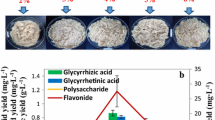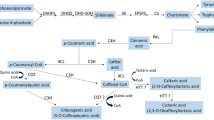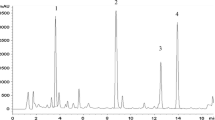Abstract
In this study, the quantification of scopolamine from Brugmansia candida normal roots is described. The roots were obtained and cultured in half salts strength Schenk and Hildebrandt (1/2 SH) liquid medium plus 30 g l−1 sucrose and supplemented with 3 mg l−1 of α-naphthaleneacetic acid. The quantitative determination of scopolamine was carried out by HPLC. The maximum scopolamine production in Brugmansia candida normal root culture was 3.94±0.01 mg g−1 dry weight obtained at 24th day of culture.
Similar content being viewed by others
References
Arteaga de GL, Perea M & Reguero MT (1993) Brugmansia: una especie promisoria para la producción de alcaloides del tropano. Revista Colombiana de Ciencias Químico-Farmacéutica 21: 36–39
Bruneton J (1991) Elementos de Fitoquímica y Farmacognosia. In: ´ Elementos de Fitoquímica y Farmacognosia (pp. 355–391). Acribia Zaragoza
Carrizo CN, Pitta-Alvarez SI, Kogan MJ, Giulietti AM & Tomaro ML (2001) Occurence of cadaverine in hairy roots of Brugmansia candida. Phytochemistry 57: 759–763
Doran PM (1997) Alteration of metabolite formation and morphological properties of hairy roots by environmental stimuli. In: Doran PM (ed) Hairy Roots – Culture and Applications (pp. 43–49). Harwood Academic Publishers, Amsterdam
Miraldi E, Masti A, Ferri S & Barni I (2001) Distribution of hyoscyamine and scopolamine in Datura stramonium. Fitoterapia 72: 644–648
Pitta-Alvarez SI & Giulietti AM (1995) Advantages and limitations in the use of hairy root cultures for the production of tropane alkaloids: Use of anti-auxins in the maintenance of normal root morphology. In-vitro Cell Dev. Biol. Plant. 31: 215–220
Roses OE, Villamil EE & Garcia Fernández JC (1988) Pharmaco-dynamic action of B. candida flowers. Fitoterapia 59: 120–127
Schenk RV & Hilderbrandt AC (1972) Medium and techniques for induction and growth of monocotyledonous and dicotyledonous plant cell cultures. Can. J. Bot. 50: 199–204
Verpoorte R, Contin A & Memelink J (2002) Biotechnology for the production of plant secondary metabolites. Phytochem. Rev. 1: 13–25
Zárate R (1999) Tropane alkaloid production by Agrobacterium rhizogenes transformed hairy root cultures of Atropa baetica willk (Solanaceae). Plant Cell Rep. 18: 418–423
Author information
Authors and Affiliations
Corresponding author
Rights and permissions
About this article
Cite this article
Niño, J., Gallego, C.M., Correa, Y.M. et al. Production of scopolamine by normal root cultures of Brugmansia candida . Plant Cell, Tissue and Organ Culture 74, 289–291 (2003). https://doi.org/10.1023/A:1024028923849
Issue Date:
DOI: https://doi.org/10.1023/A:1024028923849




